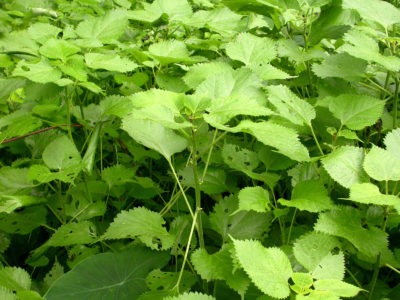
Ramie - Photo by Scamperdale
Ramie is a fiber crop. It has been used for at least 6,000 years, especially in China, to produce fabrics. The fibers used for textiles come from the inner bark (phloem) of the vegetative stalks.
Names
Scientific
Boehmeria nivea
English
China grass
Ramie
True ramie
White ramie
Dutch
Ramie
Spanish
Ramio
French
Ramie
German
Chinagras
Ramie
Italian
Ramiè
Taxonomy
Order
Rosales
Family
Urticaceae
Genus
Boehmeria
Species
Boehmeria nivea (Ramie)
Basic information and facts
Origin:
Eastern Asia
Distribution:
Main production is in China, followed by Japan, Taiwan, the Philippines, and Brazil.
Annual, biennial, or perennial:
Ramie is a herbaceous perennial plant.
Leaves:
Ramie has heart-shaped leaves, which are 7 to 15 cm long and 6 to 12 cm wide. Leave are white on the underside and covered with dense small hairs. Ramie is related to stinging nettles, but its hairs do not sting.
Climate and weather:
Prefers a warm and humid climate with a lot of rainfall.
Height:
The plants are 1 to 2.5 meters tall.
Propagation:
Usually propagated with cuttings from underground stems.
Harvesting:
The plants can be harvested several times per year. They are harvested just before the plant starts flowering, by cutting just above the lateral roots.
Uses:
The fibers of the inner bark of the stalks are used to produce textiles and products such as industrial sewing thread, packing materials, fishing nets, filter cloths and bio-plastics. Sometimes Ramie is grown as an ornamental plant.
Crop categories
Fiber crops
Minor crops
Ornamental plants
Subtropical crops
Temperate crops
Tropical crops
